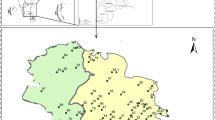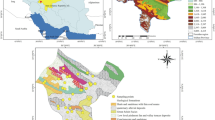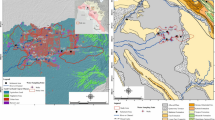Abstract
The primary goal of this study is to evaluate the groundwater quality and conduct a non-carcinogenic risk assessment of nitrate contamination in an industrialized and high-density region of South India. A total of 40 sampling sites were identified in and around the industrial area, and samples were collected during the pre-monsoon and post-monsoon seasons. Piper and Gibbs’ diagram shows that rock-water interaction, lithological characteristics and ion-exchange processes are the primary factors determining groundwater quality. The novel entropy water quality index (EWQI) indicated that 32 and 37.5% of the water in the study area were unsuitable for drinking purposes during both the pre-monsoon and post-monsoon seasons, respectively. Due to landfill leachate and modern agricultural activity, the nitrate concentration in groundwater post-monsoon had increased by 17.11%. The nitrate pollution index (NPI) value of groundwater exceeded the contaminated level by 22.77%. The non-carcinogenic human health risk assessment revealed that 35 and 40% of adult males, 37.5 and 52.5% of adult females and 42.5 and 55% of children during the pre-monsoon and post-monsoon periods were exposed to an increased concentration of nitrate in groundwater. The non-carcinogenic risk level to the exposed population in the study region descends in the following order: children > > females > males. The study suggests that low body weight in children is a direct result of consumption of low-quality water and that adult men and women suffer less severe consequences.











Similar content being viewed by others
Data availability
The datasets used and/or analysed during the current study are available in the attached supplementary file/from the corresponding author on request.
References
Adimalla N, Wu J (2019) Groundwater quality and associated health risks in a semi-arid region of south India: implication to sustainable groundwater management. Hum Ecol Risk Assess Int J 25(1–2):191–216
Adimalla N, Li P, Venkatayogi S (2018a) Hydrogeochemical evaluation of groundwater quality for drinking and irrigation purposes and integrated interpretation with water quality index studies. Environ Process 5:363–383. https://doi.org/10.1007/s40710-018-0297-4
Adimalla N, Li P, Qian H (2018b) Evaluation of groundwater contamination for fluoride and nitrate in semi-arid region of Nirmal Province, South India: a special emphasis on human health risk assessment (HHRA). Hum Ecol Risk Assess 25:1107–1124. https://doi.org/10.1080/10807039.2018.1460579
Adimalla N, Qian H (2019) Hydrogeochemistry and fluoride contamination in the hard rock terrain of central Telangana, India: analyses of its spatial distribution and health risk. SN Appl Sci 1:202–210. https://doi.org/10.1007/s42452-019-0219-8
Adimalla N, Qian H, Li P (2019b) Entropy water quality index and probabilistic health risk assessment from geochemistry of groundwaters in hard rock terrain of Nanganur Conty, South India. Geochemistry 125544. https://doi.org/10.1016/j.chemer.2019.125544
Adimalla N, Taloor AK (2020) Hydrogeochemical investigation of groundwater quality in the hard rock terrain of South India using Geographic Information System (GIS) and groundwater quality index (GWQI) techniques. Groundw Sustain Dev 10:100288. https://doi.org/10.1016/j.gsd.2019.100288
Ahada CPS, Suthar S (2018) Assessing groundwater hydrochemistry of Malwa Punjab. India Arab J Geosci 11(2):17. https://doi.org/10.1007/s12517-017-3355-8
APHA (2005) Standard methods for estimation of water and waste water, 19th edn. American Public Health Association, Washington, DC
Balamurugan P, Balakumaran S (2015) Soil quality assessment around magnesite mines and salem township using GIS techniques. Int J Adv Eng Technol 8:1997–2003
Balamurugan P, Kumar PS, Shankar K, Nagavinothini R, Vijayasurya K (2020a) Non-carcinogenic risk assessment of groundwater in southern part of Salem district in Tamilnadu, India. J Chil Chem Soc 65:4697–4707. https://doi.org/10.4067/S0717-97072020000104697
Balamurugan P, Kumar PS, Shankar K, Sajil Kumar PJ (2020b) Impact of climate and anthropogenic activities on groundwater quality for domestic and irrigation purposes in Attur region Tamilnadu, India. Desalin Water Treat 208:172–195
Balamurugan P, Kumar PS, Shankar K (2020c) Dataset on the suitability of groundwater for drinking and irrigation purposes in the Sarabanga River region, Tamil Nadu, India. Data in Brief 29:105255. https://doi.org/10.1016/j.dib.2020.105255
Balamurugan P, Shunmugapriya K, Vanitha R (2020d) GIS based assessment of ground water for domestic and irrigation purpose in Vazhapadi Taluk Salem, Tamil Nadu, India. Taiwan Water Conserv 68:1–10
Balamurugan P, Kumar PS (2016) Quality of ground water assessment in Salem District using GIS Techniques. Adv Nat Appl Sci 10:22–32
Batabyal AK, Gupta S (2017) Fluoride-contaminated groundwater of Birbhum district, West Bengal, India: interpretation of drinking and irrigation suitability and major geochemical processes using principal component analysis. Environ Monit Assess 189:369–393. https://doi.org/10.1007/s10661-017-6041-0
Bikundia DS, Mohan D (2014) Major ion chemistry of the ground water at the Khoda Village, Ghaziabad, India. Sustain Water Qual Ecol 3:133–150. https://doi.org/10.1016/j.swaqe.2014.12.001
Binh TQ, Thuy NT (2008) Assessment of the influence of interpolation techniques on the accuracy of digital elevation model. VNU J Sci Earth Sci 24:176–183
BIS (2012) Drinking water specifications. Bureau of Indian Standards IS, New Delhi, p 10500
Chaitanya BP, Kanak M (2018) Spatial analysis of groundwater quality mapping in hard rock area in the Akola and Buldhana districts of Maharashtra, India. Appl Water Sci 8:1–17. https://doi.org/10.1007/s13201-018-0754-2
Chaitanya BP, Kanak NM, Sudhir KS, Bloodless D (2019) Groundwater evaluation for drinking purposes using statistical index: study of Akola and Buldhana districts of Maharashtra, India. Environ Dev Sustain 22:7453–7471. https://doi.org/10.1007/s10668-019-00531-0
Climate-Data.Org. https://en.climate-data.org/asia/india/tamil-nadu/karur-24030/; last Accessed 04.01.2021
Colins J, Sashikkumar MC, Anas PA, Kirubakaran M (2016) GIS-based assessment of aquifer vulnerability using DRASTIC Model: a case study on Kodaganar basin. Earth Sci Res J 20:1–8. https://doi.org/10.15446/esrj.v20n1.52469
Egbueri JC (2020) Heavy metals pollution source identification and probabilistic health risk assessment of shallow groundwater in Onitsha, Nigeria. Anal Lett 53:1620–1638. https://doi.org/10.1080/00032719.2020.1712606
Gajbhiye S, Meshram C, Singh SK, Srivastava PK, Islam T (2016) Precipitation trend analysis of Sindh River basin, India, from 102-year record (1901–2002). Atmos Sci Lett 17:71–77. https://doi.org/10.1002/asl.602
Gibbs RJ (1970) Mechanism controlling world’s water chemistry. Science 170:1088–1090
Guo, B., Yang, F., Wu, H., Zhang, R., Zang, W., Wei, C., ... & Zhang, H. (2021). How the variations of terrain factors affect the optimal interpolation methods for multiple types of climatic elements?. Earth Science Informatics, 14(2), 1021-1032.
Hoseinzadeh E, Wei C, Chavoshi E, Amin FM (2016) Groundwater quality and nitrate pollution modeling: an integrated study of contour mapping and geographic information system. Desalin Water Treat 57:24882–24893. https://doi.org/10.1080/19443994.2016.1150886
Islam ARMT, Al Mamun A, Rahman MM, Zahid A (2020) Simultaneous comparison of modified-integrated water quality and entropy weighted indices: implication for safe drinking water in the coastal region of Bangladesh. Ecol Indic 113:106229. https://doi.org/10.1016/j.ecolind.2020.106229
Jacintha TGA, Rawat KS, Mishra A, Singh SK (2016) Hydrogeochemical characterization of groundwater of Peninsular Indian region using multivariate statistical techniques. Appl Water Sci 7:3001–3013. https://doi.org/10.1007/s13201-016-0400-9
Jasrotia AS, Taloor AK, Andotra U, Kumar R (2019) Monitoring and assessment of groundwater quality and its suitability for domestic and agricultural use in the Cenozoic rocks of Jammu Himalaya, India: a geospatial technology-based approach. Groundw Sustain Dev 8:554–566. https://doi.org/10.1016/j.gsd.2019.02.003
Kamble BS (2016) Characterization of leachate and its effects on ground water quality around Jawahar nagar municipal open dumpsite, Rangareddy, Telangana. Curr World Environ 11:114. https://doi.org/10.12944/CWE.11.1.15
Kaur L, Rishi MS, Siddiqui AU (2020) Deterministic and probabilistic health risk assessment techniques to evaluate non-carcinogenic human health risk (NHHR) due to fluoride and nitrate in groundwater of Panipat, Haryana, India. Environ Pollut 259:113711
Kaur L, Rishi MS, Sharma S, Sharma B, Lata R, Singh G (2019) Hydrogeochemical characterization of groundwater in alluvial plains of River Yamuna in Northern India: an insight of controlling processes. Journal of King Saud University-Science 31(4):1245–1253
Kumar D, Singh A, Jha RK, Sahoo BB, Sahoo SK, Jha V (2019) Source characterization and human health risk assessment of nitrate in groundwater of middle Gangetic Plain, India. Arab J Geosci 12(11):1–12
Kumar MS, Dhakate R, Yadagiri G, Reddy KS (2017) Principal component and multivariate statistical approach for evaluation of hydrochemical characterization of fluoride-rich groundwater of Shaslar Vagu watershed, Nalgonda District, India. Arab J Geosci 10:83. https://doi.org/10.1007/s12517-017-2863-x
Kumar PS, Balamurugan P (2018) Evaluation of groundwater quality for irrigation purpose in Attur taluk, Salem, Tamilnadu, India. Water Energy Int 61:59–64
Kumar PS, Balamurugan P (2019) Suitability of ground water for irrigation purpose in Omalur Taluk, Salem, Tamil Nadu, India. Indian J Ecol 46:1–6
Kumar, M., Nagdev, R., Tripathi, R., Singh, V. B., Ranjan, P., Soheb, M., & Ramanathan, A. L. (2019). Geospatial and multivariate analysis of trace metals in tubewell water using for drinking purpose in the upper Gangetic basin, India: heavy metal pollution index. Groundwater for Sustainable Development, 8, 122-133.
Li P, Wu J, Qian H (2016) Hydrogeochemical characterization of groundwater in and around a wastewater irrigated forest in the south-eastern edge of the Tengger Desert, Northwest China. Expo Health 8:331–348. https://doi.org/10.1007/s12403-016-0193-y
Marghade D, Malpe DB, Duraisamy K, Patil PD, Li P (2020) Hydrogeochemical evaluation, suitability, and health risk assessment of groundwater in the watershed of Godavari basin, Maharashtra, Central India. Environ Sci Pollut Res: 1–24. https://doi.org/10.1007/s11356-020-10032-7
Moharir K, Pande C, Singh S, Choudhari P, Kishan R, Jeyakumar L (2019) Spatial interpolation approach-based appraisal of groundwater quality of arid regions. J Water Supply Res T 68:431–447. https://doi.org/10.2166/aqua.2019.026
Mudur G (2003) India’s burden of waterborne diseases is underestimated. BMJ: Br Med J 326(7402):1284
Narsimha, A., & Rajitha, S. (2018). Spatial distribution and seasonal variation in fluoride enrichment in groundwater and its associated human health risk assessment in Telangana State, South India. Human and Ecological Risk Assessment: An International Journal, 24(8), 2119-2132
Obeidat, M. M., Awawdeh, M., Al-Rub, F. A., & Al-Ajlouni, A. (2012). An innovative nitrate pollution index and multivariate statistical investigations of groundwater chemical quality of Umm Rijam Aquifer (B4), North Yarmouk River Basin, Jordan. Vouddouris K, Voutsa D. Water Quality Monitoring and Assessment. Croatia: InTech, 169-188
Panaskar DB, Wagh VM, Muley AA, Mukate SV, Pawar RS, Aamalawar ML (2016) Evaluating groundwater suitability for the domestic, irrigation, and industrial purposes in Nanded Tehsil, Maharashtra, India, using GIS and statistics. Arab J Geosci 9:615. https://doi.org/10.1007/s12517-016-2641-1
Panneerselvam B, Karuppannan S, Muniraj K (2020a) Evaluation of drinking and irrigation suitability of groundwater with special emphasizing the health risk posed by nitrate contamination using nitrate pollution index (NPI) and human health risk assessment (HHRA). Hum Ecol Risk Assess: 1–25. https://doi.org/10.1080/10807039.2020.1833300
Panneerselvam B, Paramasivam SK, Karuppannan S, Ravichandran N, Selvaraj P (2020b) A GIS-based evaluation of hydrochemical characterisation of groundwater in hard rock region, South Tamil Nadu, India. Arab J Geosci 13:1–22. https://doi.org/10.1007/s12517-020-05813-w
Piper AM (1953) A graphic procedure in the chemical interpretation of water analysis. US Geological Survey Groundwater Note. 12
Ponsadailakshmi S, Sankarib G, Prasanna SC, Madhurambal G (2018) Evaluation of water quality suitability for drinking using drinking water quality index in Nagapattinam district, Tamil Nadu in southern India. Groundw Sustain Dev 6:43–49. https://doi.org/10.1016/j.gsd.2017.10.005
Rawat K, Pradhan S, Tripathi V, Jeyakumar L, Singh SK (2019) Statistical approach to evaluate groundwater contamination for drinking and irrigation suitability. Groundw Sustain Dev 9:100251. https://doi.org/10.1016/j.gsd.2019.100251
Reddy AGS (2014) Geochemical evaluation of nitrate and fluoride contamination in varied hydrogeological environs of Prakasam district, southern India. Environ Earth Sci 71:4473–4495. https://doi.org/10.1007/s12665-013-2841-x
Rishi MS, Kaur L, Sharma S (2020) Groundwater quality appraisal for non-carcinogenic human health risks and irrigation purposes in a part of Yamuna sub-basin, India. Hum Ecol Risk Assess Int J 26(10):2716–2736
Sajil Kumar PJ (2017) Geostatistical modelling of fluoride enrichment and nitrate contamination in the groundwater of Lower Bhavani Basin in Tamil Nadu, India. Model Earth Syst Environ 3:1–18. https://doi.org/10.1007/s40808-016-0260-1
Satyanarayana E, Dhakate R, Kumar DL, Ravindar P, Muralidhar M (2017) Hydrochemical characteristics of groundwater quality with special reference to fluoride concentration in parts of Mulugu-Venkatapur Mandals, Warangal district, Telangana. J Geol Soc India 89:247–258. https://doi.org/10.1007/s12594-017-0597-8
Shaikh H, Gaikwad H, Kadam A, Umrikar B (2020) Hydrogeochemical characterization of groundwater from semiarid region of western India for drinking and agricultural purposes with special reference to water quality index and potential health risks assessment. Appl Water Sci 10:1–16. https://doi.org/10.1007/s13201-020-01287-z
Shannon CE (1948) A mathematical theory of communication. Bell Syst Tech J 27(379–423):623–656
Singaraja C (2017) Relevance of water quality index for groundwater quality evaluation: Thoothukudi District, Tamil Nadu, India. Appl Water Sci 7:2157–2173. https://doi.org/10.1007/s13201-017-0594-5
Singh G, Rishi MS, Herojeet R, Kaur L, Sharma K (2020) Evaluation of groundwater quality and human health risks from fluoride and nitrate in semi-arid region of northern India. Environ Geochem Health 42(7):1833–1862
Singh, D. D., Thind, P. S., Sharma, M., Sahoo, S., & John, S. (2019). Environmentally sensitive elements in groundwater of an industrial town in India: Spatial distribution and human health risk. Water, 11(11), 2350.
Subba Rao N (2018) Groundwater quality from a part of Prakasam District, Andhra Pradesh, India. Appl Water Sci 8:1–18. https://doi.org/10.1007/s13201-018-0665-2
Subba Rao N, Sunitha B, Adimalla N, Chaudhary M (2019) Quality criteria for groundwater use from a rural part of Wanaparthy District, Telangana State, India, through ionic spatial distribution (ISD), entropy water quality index (EWQI) and principal component analysis (PCA). Environ Geochem Health 42:579–599. https://doi.org/10.1007/s10653-019-00393-5
Sudhakar A, Narsimha A (2013) Suitability and assessment of groundwater for irrigation purpose: a case study of Kushaiguda area, Ranga Reddy district, Andhra Pradesh, India. Adv Appl Sci Res 4:75–81
Tan, Q., & Xu, X. (2014). Comparative analysis of spatial interpolation methods: an experimental study. Sensors & Transducers, 165(2), 155-163.
Thomson BM, Nokes CJ, Cressey PJ (2007) Intake and risk assessment of nitrate and nitrite from New Zealand foods and drinking water. Food Addit Contam 24(2):113–121
U.S. EPA (2006) USEPA region III risk-based concentration table: technical background information. United States Environmental Protection Agency, Washington, DC
U.S. EPA. 2014. Human health evaluation manual, supplemental guidance: update of standard default exposure factors-OSWER Directive 9200.1–120. PP.6
Vasanthavigar M, Srinivasamoorthy K, Vijayaragavan K, Ganthi RR, Chidambaram S, Anandhan P, Vasudevan S (2010) Application of water quality index for groundwater quality assessment: Thirumanimuttar sub-basin, Tamilnadu, India. Environ Monit Assess 171:595–609. https://doi.org/10.1007/s10661-009-1302-1
Wagh VM, Panaskar DB, Muley AA (2017) Estimation of nitrate concentration in groundwater of Kadava river basin-Nashik district, Maharashtra, India by using artificial neural network model. Model Earth Syst Environ 3:1–20. https://doi.org/10.1007/s40808-017-0290-3
Wagh VM, Panaskar DB, Varade AM, Mukate SV, Gaikwad SK, Pawar RS, Muley AA, Aamalawar ML (2016) Major ion chemistry and quality assessment of the groundwater resources of Nanded tehsil, a part of south-east Deccan Volcanic Province, Maharashtra. India Environ Earth Sci 75:1418. https://doi.org/10.1007/s12665-016-6212-2
Wakida FT, Lerner DN (2005) Non-agricultural sources of groundwater nitrate: a review and case study. Water Res 39(1):3–16
Wang H, Lu K, Shen C, Song X, Hu B, Liu G (2021) Human health risk assessment of groundwater nitrate at a two geomorphic units transition zone in northern China. J Environ Sci. https://doi.org/10.1016/j.jes.2021.03.013
WHO (2017) Guidelines for drinking water quality, 4th edition incorporating the first addendum. World Health Organization, Geneva
World Health Organization (2003) Nitrate and nitrite in drinking water: background document for preparation of WHO guidelines for drinking water quality. World Health Organization
Yehia M, Baghdady A, Howari FM, Awad S, Gad A (2017) Natural radioactivity and groundwater quality assessment in the northern area of the Western Desert of Egypt. J Hydrol Reg Stud 12:331–344. https://doi.org/10.1016/j.ejrh.2017.06.002
Zhai Y, Zhao X, Teng Y, Li X, Zhang J, Wu J, Zuo R (2017) Groundwater nitrate pollution and human health risk assessment by using HHRA model in an agricultural area, NE China. Ecotoxicol Environ Saf 137:130–142
Zhou Y, Ning J, Li L, Long Q, Wei A, Liu Z (2020) Health risk assessment of groundwater in Gaobeidian, North China: distribution, source, and chemical species of the main contaminants. Expo Health 12:427–446. https://doi.org/10.1007/s12403-020-00365-6
Author information
Authors and Affiliations
Contributions
Balamurugan Panneerselvam—conceptualization, methodology, formal analysis, data curation, validation and original draft writing.
Kirubakaran Muniraj—visualization and mapping.
Chaitanya Pande—original draft writing, review and editing.
Nagavinothini Ravichandran—review and editing.
Maciej Thomas—supervision, data curation, writing—review and editing.
Shankar Karuppannan—review and editing.
All authors have read and agreed to the published version of the manuscript.
Corresponding author
Ethics declarations
Ethics approval
Not applicable.
Consent to participate
I am free to contact any of the people involved in the research to seek further clarification and information.
Consent for publication
The authors grant the journal/publisher the sole and exclusive licence of the full copyright in the contribution. Consequently, the journal/publisher shall have the exclusive right throughout the world to publish and sell the contribution in all languages, and in any form i.e. hard copy, digital and electronic form.
Competing interests
The authors declare no competing interests.
Additional information
Responsible Editor: Xianliang Yi
Publisher's note
Springer Nature remains neutral with regard to jurisdictional claims in published maps and institutional affiliations.
Supplementary Information
Below is the link to the electronic supplementary material.
Rights and permissions
About this article
Cite this article
Panneerselvam, B., Muniraj, K., Pande, C. et al. Geochemical evaluation and human health risk assessment of nitrate-contaminated groundwater in an industrial area of South India. Environ Sci Pollut Res 29, 86202–86219 (2022). https://doi.org/10.1007/s11356-021-17281-0
Received:
Accepted:
Published:
Issue Date:
DOI: https://doi.org/10.1007/s11356-021-17281-0




